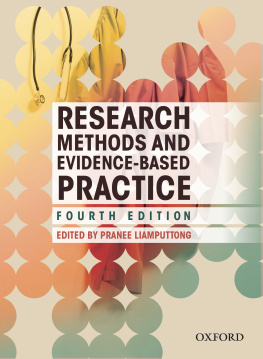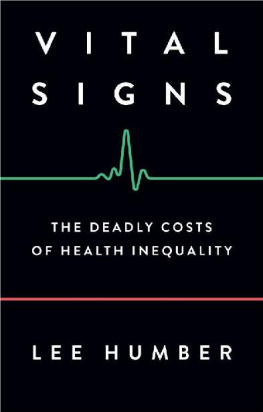Contents
List of Figures
List of Tables
Guide
Pages
Health Inequality
An Introduction to Concepts, Theories and Methods
Second Edition
Mel Bartley
polity
Copyright Mel Bartley 2017
The right of Mel Bartley to be identified as Author of this Work has been asserted in accordance with the UK Copyright, Designs and Patents Act 1988.
First edition published in 2004 by Polity Press
This second edition first published in 2017 by Polity Press
Polity Press
65 Bridge Street
Cambridge CB2 1UR, UK
Polity Press
350 Main Street
Malden, MA 02148, USA
All rights reserved. Except for the quotation of short passages for the purpose of criticism and review, no part of this publication may be reproduced, stored in a retrieval system, or transmitted, in any form or by any means, electronic, mechanical, photocopying, recording or otherwise, without the prior permission of the publisher.
ISBN-13: 978-0-7456-9112-1
A catalogue record for this book is available from the British Library.
Library of Congress Cataloging-in-Publication Data
Names: Bartley, Mel, author.
Title: Health inequality : an introduction to concepts, theories and methods / Mel Bartley.
Description: 2nd edition. | Cambridge, UK ; Malden, MA : Polity, 2016. | Includes bibliographical references and index.
Identifiers: LCCN 2016014155 (print) | LCCN 2016018268 (ebook) | ISBN 9780745691091 (hardcover : alk. paper) | ISBN 0745691099 (hardcover : alk. paper) | ISBN 9780745691107 (pbk. : alk. paper) | ISBN 0745691102 (pbk. : alk. paper) | ISBN 9780745691121 (mobi) | ISBN 9780745691138 (epub)
Subjects: | MESH: Health Status Disparities | Models, Theoretical | Socioeconomic Factors
Classification: LCC RA418 (print) | LCC RA418 (ebook) | NLM WA 300.1 | DDC 362.1--dc23
LC record available at https://lccn.loc.gov/2016014155
The publisher has used its best endeavours to ensure that the URLs for external websites referred to in this book are correct and active at the time of going to press. However, the publisher has no responsibility for the websites and can make no guarantee that a site will remain live or that the content is or will remain appropriate.
Every effort has been made to trace all copyright holders, but if any have been inadvertently overlooked the publisher will be pleased to include any necessary credits in any subsequent reprint or edition.
For further information on Polity, visit our website: www.politybooks.com
Acknowledgements
Mel Bartley thanks the Centre for Longitudinal Studies, Institute of Education, for the use of the 1958 birth cohort data and the United Kingdom Data Archive and Economic and Social Data Service for making those data available. None of the organizations that provided access to data had responsibility for the analysis or interpretation of these data.
This book owes a great deal to past and present colleagues, in particular Amanda Sacker, Meena Kumari, Pekka Martikainen, Archana Sing-Manoux, Paul Clarke, Mai Stafford and Eric Brunner, Updating the British official data on health inequality would not have been possible without the help of Peter Goldblatt.
Introduction to the Second Edition
Many of those who studied health inequality in the 1970s and 1980s saw it as a chance to improve our understanding of disease and our ability to prevent ill health in the whole population, regardless of social background. Social differences in premature mortality from almost all causes were so large; it seemed that if we could understand the ways in which socio-economic adversity gets under the skin to produce disease, this might lead to major improvements in population health and ways of making medical care more effective. What is the point, we asked, of treating someones bronchitis in hospital and then sending them back to a damp, cold house to become ill again? The existence of health inequalities was seen as proof that diseases were indeed preventable by changes to the environment. Since 1948 the British National Health Service offered medical care free at the time of use to all citizens, but by the 1970s it was clear that free health care was not reducing the size of health inequalities; in fact, they increased (see ). This was all the more encouragement to regard prevention as better than cure. After all, even free operations are not a pleasant experience; most people would prefer not to become ill in the first place. But more surprising was that health inequalities continued to increase even after 40 years of a welfare state that in theory prevented the worst extremes of poverty and that had actually succeeded in reducing income inequality.
The Black Report of 1980 was the first attempt to drill down into the statistics and identify what it was about social class (the measure of social inequality used in British official statistics) that produced these large differences in risk. The Black Report put forward four possible models of explanation: selection, artefact, material and behavioural-cultural. In the early 2000s, the artefact explanation had been completely discredited and the selection explanation was little considered outside of economics. Accordingly, the first edition of this book concentrated on the material and behavioural-cultural models and tried to assess how well each of them fitted the existing evidence. It also described and assessed three additional factors that had been increasingly investigated in research between 1980 and 2000: psycho-social stress at work, social isolation and life-course effects. In this second edition, this evidence will be updated, but consideration will also be given to some of the more recent thinking that has arisen, particularly what the evidence has to say about the importance of individual characteristics for health inequality.
Between 1997 and 2001, when the ideas behind this book were being gestated and written down, the United Kingdom had a New Labour (moderate social democratic) government that was in many ways determined to reduce health inequality and was prepared to do so by addressing at least some of the social and economic factors (the so-called upstream factors) believed to be involved, such as the absence of a minimum wage, low pensions, widespread educational failure and child poverty. The successor to the Black Report, the Acheson Report, set out a large number of rather precise recommendations (Acheson 1998), and a government plan published in 2002 described the ways in which many of these would be met (Department of Health 2002). As pointed out by Mackenbach (Mackenbach 2010a, 2010b), the British programme was by far the best resourced of all the Western European strategies to reduce health inequalities which started during the decade. It should have been a golden age during which the research paid off in terms of real-world reductions in health disparities between social groups, and overall improvements in population health.
So it has been surprising and dismaying to see the verdict on the past 10 years of policy initiatives: that they have not succeeded in reducing health inequality in the United Kingdom (Department of Health 2009; Mackenbach 2010a; Law, Parkin and Lewis 2012). At least, not as far as we can tell. It is not easy to trace the changes in health inequality since 1997 because the availability of data that can be used to evaluate the success or failure of new policies has changed. This has made it quite hard to compare the situation now with that in 1997 and 2014 (let alone any further back). When I decided it was time to update Health Inequality, the first thing to do was to revise the tables and figures. This seemed like it would be a simple task. But it did not turn out that way. For a start, the evaluations proposed in the 2002 report Tackling Health Inequalities only required a comparison of mortality by geographical areas, not by social class as had been done every 10 years since 1921 in England and Wales. Social class gaps were only assessed in infant mortality. It appears that the degree of class inequality in infant mortality did begin to fall quite a lot (Bambra 2012), though it may have risen again after 2010. The gaps in adult life expectancy between the most and least deprived areas, at least in England, have remained stubbornly unchanged, or even slightly increased (Law et al. 2012; Vizard and Obolenskaya 2013). But that is not the same as being able to extend the 70-year old analysis of social class differences in premature death that gave rise to the whole issue of health inequality in the first place.









